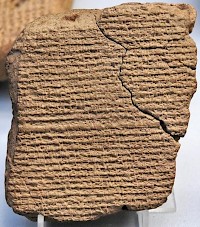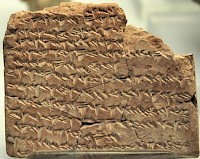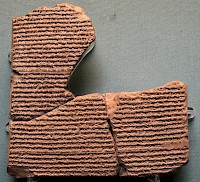Astronomical Diaries
Astronomical diaries: collection of Babylonian texts in which astronomical observations and political events are recorded.
The Omen Catalogue

One of the most remarkable texts from ancient Mesopotamia is the collection of celestial omens known as Enûma Anu Enlil, which was discovered in the library of the Assyrian king Aššurbanipal in Nineveh. The authors of these seventy tablets believed that the gods had created the movements of the planets to give the people on earth indications of the future. Enûma Anu Enlil was a dictionary of the heavenly language and contains all kinds of explanations, like:
When in the month Ajaru, during the evening watch, the moon eclipses, the king will die. The sons of the king will vie for the throne of their father, but will not sit on it.note
The interesting thing is that these predictions were not, like the horoscopes in our newspapers, invented by charlatans. Although the general idea behind Enûma Anu Enlil, that the gods used the planets to show us the future, is wrong, the Mesopotamian astronomers used a purely scientific method. They observed the skies, collected data, discovered regularities, and warned the authorities when they knew something bad was about to happen. The astronomers of Assyria and Babylonia, usually called Chaldaeans, are the fathers of science - or at least of the scientific method and the disciplines of astronomy, and, as we shall see below, historiography.
The Astronomical Diaries
The first stage of the Chaldaean scientific project was the recording of the celestial phenomena and their correlation with important political events. The Astronomical Diaries, a large collection of texts from Babylon that is now in the British Museum, offer exactly that. A complete Diary dealt with six months, each divided into two halves:
- The astronomical observations, arranged day by day. We learn about the positions of the moon, eclipses, solstices, equinoxes, and the positions of the planets. The rising and setting of Sirius are also noted. Sometimes, the Chaldaean who wrote the texts disarmingly remarks "clouds were in the sky" or "I did not watch". It ends with a summary.
- Acts and facts that were thought to have been predicted by the celestial omens. Here, we can find the level of the river Euphrates, the prices of commodities (barley, dates, mustard, sesame, wool...), and political events.
It is likely that the regular observation of the skies started during the reign of king Nabu-Nasir (r.747-734). Our oldest tablet dates back to 652/651; the youngest to 61/60 BCE. The activities of the Chaldaeans are probably the longest research program ever.

A very interesting example is the tablet dealing with the battle of Gaugamela on 1 October 331, in which Alexander the Great defeated his opponent, the Achaemenid king Darius III Codomannus and conquered Mesopotamia (text). First, there must have been the dating formula, which is now lost but can be reconstructed:
Year 5 of Artašata who is called Darius, month 6.
Then, the author describes the celestial omens, which happen to be quite spectacular:
Day 13 [20 September]: Sunset to moonrise: 8º. There was a lunar eclipse. Its totality was covered at the moment when Jupiter set and Saturn rose. During totality the west wind blew, during clearing the east wind. During the eclipse, deaths and plague occurred.Day 14: All day clouds were in the sky.Day 15: Sunset to moonrise: 16º. There were clouds in the sky. The moon was 32/3 cubits below [the star] Alpha Arietis, the moon having passed to the east. A meteor which flashed, its light was seen on the ground; very overcast, lightning flashed.
The lunar eclipse is also known from Greek and Latin sources, which mention that Alexander sacrificed to the sun, moon, and earth (incidentally proving that the Macedonian king knew what caused an eclipse). As we will see below, there is a lot more to be said about this omen.
The next parts of the Diary are the summary of the preceding texts, and the description of the events that were believed to be predicted by the omens: the level of the Euphrates, the prices of commodities and political events - in this case, the decisive battle in the war between Macedonia and Persia:
That month, the equivalent for 1 shekel of silver was: barley [lacuna] kur; mustard, 3 kur, at the end of the month [lacuna]; sesame, 1 pân, 5 minas.At that time, Jupiter was in Scorpio; Venus was in Leo, at the end of the month in Virgo; Saturn was in Pisces; Mercury and Mars, which had set, were not visible.That month, the river level was [lacuna].On the 11th of that month, panic occurred in the camp before the king. The Macedonians encamped in front of the king.On the 24th [1 October], in the morning, the king of the world [Alexander] erected his standard and attacked. Opposite each other they fought and a heavy defeat of the troops of the king [Darius] he [Alexander] inflicted. The king [Darius], his troops deserted him and to their cities they went. They fled to the east.
No Chaldaean could have been surprised by this outcome of the battle. After all, the significance of the eclipse was described in Enûma Anu Enlil. Here is the explanation:
If on either the 13th or 14th Ulûlu the moon is dark; the watch passes and it is dark; his features are dark like lapis lazuli; he is obscured until his midpoint; the west quadrant - as it covered, the west wind blew; the sky is dark; his light is covered.The significance is: The son of the king will become purified for the throne but will not take the throne. An intruder will come with the princes of the west; for eight years he will exercise kingship; he will conquer the enemy army; there will be abundance and riches on his path; he will continually pursue his enemies; and his luck will not run out.note
Other aspects are explained in the commentary known as Šumma Sîn ina tâmartîšu. An eclipse on the 13th brought evil to Akkad (=Babylonia), month Ulûlu meant evil for Elam (=Persia), western wind at the beginning of the eclipse implied that doom was to come from the west. The visibility of Saturn added to the urgency of this omen; Jupiter, which could have neutralized it, had set.
Under normal circumstances, the Chaldaeans would have advised the king to make sacrifices, which could avert the danger. Indeed, one of our sources, Quintus Curtius Rufus, tells us that Darius performed additional rituals in the night before the battle.
The ultimate ritual (not mentioned) was the appointment of a substitute king, a prisoner or a mentally defective man who was made king for a few days. He would bear the brunt of the gods' wrath. The real king would remain unharmed and the continuity of the state's policy was guaranteed. The poor man who was appointed as substitute king was killed. In this way, the omen was always right.
Incidentally, it may be noted that Alexander's eight-year period of luck had run out in 323. He offered the Babylonian gods to rebuild the sanctuary known as Etemenanki, and the Chaldaeans appointed a substitute king - but in vain. The "king of the world" died on 11 June 323. The paradigm of the Babylonian astronomers had been corroborated.
The scientific significance of the Diaries
Now that we have seen the contents and function of the Astronomical Diaries, we can look to the significance of these texts.

In the first place, the Chaldaeans established the rules for scientific proof. Although their point of departure was wrong, their method is identical to that of modern science. We have inherited their method through the ancient Greeks. When Alexander entered Babylon, his scientific advisor Callisthenes of Olynthus had the cuneiform tablets translated and sent them to his uncle, the philosopher Aristotle of Stagira. This is known from a very late Greek source, Simplicius; but the truth of his words is established because Simplicius correctly translates the Babylonian title of the Diaries, massartu, as têrêseis, which is illogical in Greek but keeps the double meaning of "guarding" and "observing". (The Arabian scientist Ibn Khaldun, who used other sources, tells the same.)
In the second place, the political information from the Diaries was used to write the series of Babylonian Chronicles. An example is the Alexander Chronicle, which deals with the events of the year 330 BCE:
Month IV (July): King Darius, from his throne they removed him. Bessus sat on the throne and they called him Artaxerxes. Alexander and his troops pursued Bessus the rebel king. Alexander with his few troops made battle with the troops of Bessus. Bessus killed king Darius. [...]Month V, day 15: Kidinnu was killed by the sword. [...]Month VII (October): The king was in the land of Uzuiânu, a city in the east. [...]Month IX (25 Nov - 24 Dec): He appointed [...]-Bel, his son, to the office of satrap. People plotted evil to the king.
The inverted word order ("Darius, from his throne they removed him") is typical for the omen literature (cf. in the Diary quoted above "The king, his troops deserted him"). The Chronicles show the same detached, scientific way of describing events. This is no prejudiced propaganda, but objective scholarship, and if the authors would have told us more about causality, we would call the Chaldaeans, and not the Greek researcher Herodotus of Halicarnassus, the fathers of history.
The Diaries as source for the modern historian

Finally, it should be noted that the Astronomical Diaries offer us a wealth of historical information. For example, we can say important things about the Babylonian economy. During the reign of king Artaxerxes III Ochus (358-338), the prices of commodities were low; during the reign of the early Diadochi, they were high (due to warfare?), and during the third century, they gradually normalized. No less interesting is the comparison of the prices during the summer of 333 and the spring of 323, when large armies were in Babylon. In 333, the prices were low, proving that Darius knew how to organize his logistical system; ten years later, the prices were sky-high, which suggests that Alexander did care less about the Babylonian populace.
Maybe the development of the prices has nothing to do with the economic conjecture, but with climatic changes. The fourth century BCE is known to have been a "little ice age". Climatologists have not yet used the Diaries as evidence, but it may be a possible development in the near future.
Of course, the Astronomical Diaries also offer information about politics. We learn a lot about the organization of Babylonian institutions, about officials and their titles, about events. The text about Gaugamela makes it clear that the army of Darius was deserting on the eve of the battle, and it is only a minor exaggeration to say that Alexander attacked a group of fleeing soldiers. This information flatly contradicts a classical account like that of Arrian, and should be preferred because it is contemporary and more or less confirmed by Diodorus of Sicily.
Other interesting information is, for example, that Alexander died in 11 June 323 (not 10 or 13, as has been maintained). We have gained a better understanding of the chronology of the wars of Artaxerxes II Mnemon. We now know that the Seleucid king Antiochus II Theos (261-246) had a daughter named Apame. We have gained a lot of information about the Parthian conquest of Babylon. Many examples can be added. In short, the Astronomical Diaries are a very valuable source for historical information that deserves more attention.
Literature
Reading the Astronomical Diaries is not difficult, although it must be admitted that the contents of these scientific records are dry as dust. The new standard edition is by A. Sachs and H. Hunger, Astronomical Diaries and Related Texts from Babylon (Vienna 1988-1996), which offers translations. It should be noted that the authors count the years as if they are western years, which is a bit oversimplified: the Babylonian year started in the spring (when the Akitu festival was celebrated), and the year indicated by Sachs and Hunger as "-330" is the equivalent of the year 331/330 of the common era.
- Paul Bernard, "Nouvelle contribution de l' épigraphie cunéiforme à l' histoire hellénistique" in: Bulletin de correspondance Hellénique 114 (1990) 514-541.
- Leo Depuydt, "The Time of Death of Alexander the Great: 11 June 323 BC, ca. 4:00-5:00 PM" in: Welt des Orients 28 (1997) 117-135.
- Mark Geller, "Babylonian astronomical diaries and corrections of Diodorus" in: Bulletin of the School of Oriental and African Studies 53 (1990) 1-7
- U. Koch-Westenholz, Mesopotamian astrology. An introduction to Babylonian and Assyrian astrology (1995) Copenhagen
- A.L. Slotsky, The Bourse of Babylon. Market quotations in the Astronomical Diaries of Babylonia (1997) Bethesda MD.
- Bert van der Spek, "The Astronomical Diaries as a source for Achaemenid and Seleucid History" in: Bibliotheca Orientalis 50 (1993) 91-101.
- Bert van der Spek, "New Evidence from the Babylonian Astronomical Diaries concerning Seleucid and Arsacid history" in: Archiv für Orientforschung 44/45 (1997/1998) 167-175.
- Bert van der Spek, "Darius III, Alexander the Great and Babylonian scholarship" in: Achaemenid History XIII (2003) 289-346
- Bert van der Spek & C.A. Mandemakers, "Sense and nonsense in the statistical approach of Babylonian prices" Bibliotheca Orientalis 60 (2003) 521-537.
No comments:
Post a Comment